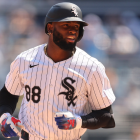
Last week, the San Francisco Giants reportedly agreed to terms with right-hander Jordan Hicks on a four-year pact worth $44 million. The Giants have not yet confirmed either the signing or the most surprising aspect of the reported deal: the assertion that Hicks will report to camp as a starting pitcher.
Hicks, 27, has predominantly pitched in relief during his big-league career. Just eight of his 212 appearances came in a starting capacity. All eight of those were contained to the 2022 season, and none more recently than that July.
Because this is the Farhan Zaidi-led Giants, it's fair to wonder if they view Hicks as a starting pitcher in the most literal sense -- that is, as the pitcher who begins the game … without any consideration for how long they remain in it afterward. The Giants have a history of this sort of thing. In 2023, they handed 23 starts to Ryan Walker and John Brebbia. Neither averaged more than 1.6 innings per, making them something more like openers than true starters.
The funny thing is that, even if the Giants do think of Hicks as a nominal starter, it would represent an uptick in his workload. He averaged three outs per appearance last season, and recorded four or more outs in just 10 of his 65 overall appearances. For reference, Hicks tallied at least four outs in 16 of his 35 appearances during the 2022 season. Either way, then, the Giants are anticipating getting more length from him than he provided last year.
So, what exactly are the Giants seeing here? Below, we've identified three reasons the Giants might be optimistic about Hicks heading forward.
1. An expanded arsenal
When you envision a Hicks appearance, you probably picture him chucking 100 mph sinkers and mixing in the occasional slider. There's some truth to that conception, but we feel obligated to note that he changed a little in 2023.
To be sure, Hicks still threw his red-hot sinker more than 60% of the time. But he found it in him to set a new career-high in four-seam usage rate, at 10.7%. He also altered his secondaries, parking his traditional slider and changeup in-season in favor of a new sweeper that proved to be his best bat misser.
Jordan Hicks, Sick 101mph Sinker Movement. 🤒 pic.twitter.com/vVeuygqO9E
— Rob Friedman (@PitchingNinja) October 3, 2023
Here's a breakdown of how those pitches fared in a few notable areas:
| Pitch | Usage% | Whiff% | Exit velocity |
|---|---|---|---|
Sinker | 64.4% | 17.9% | 86.9 mph |
Sweeper | 19.8% | 59.5% | 88.6 mph |
Four-seamer | 10.7% | 31% | 84.5 mph |
Heading into the new season, it's reasonable to expect Hicks to continue to lean on those three offerings. By no means is this your standard starter's arsenal, but it is a broader one than Hicks is accustomed to having on hand. In theory, that should allow him the ability to offer more looks to the opposition, thereby extending his effectiveness a little deeper into his outings.
Is that alone enough for Hicks to reliably work three-plus frames? Probably not. He did make gains in other areas that could bolster his chances.
2. Improved control
Along with the changes Hicks made to his repertoire, he also showcased better command than he had at any other point in his big-league career.
Mind you, Hicks still walked more than 11% of the batters he faced, a percentage that would have ranked third-highest among qualifiers, superior only to Blake Snell and Charlie Morton. That mark represented the second lowest of his career, behind the 10% he posted he managed during an injury-shortened 2019 campaign. (He threw 28 innings that year.)
Jordan Hicks, Filthy 86mph Sweeper. 😷 pic.twitter.com/tY0s1L7O4B
— Rob Friedman (@PitchingNinja) August 5, 2023
We still feel comfortable describing Hicks' geography as being improved. Take a look at how some of his control indicators stack up, including his percentage of pitches in the zone and those classified as being in competitive locations.
| Season | Strike% | Zone% | Chase% | Competitive% |
|---|---|---|---|---|
2023 | 61.4% | 49.3% | 27.8% | 82.3% |
2022 | 59.5% | 49.1% | 23.6% | 81% |
2021 | 54.9% | 43.5% | 21.4% | 81.6% |
2019 | 59.9% | 47.6% | 29% | 79.6% |
2018 | 60.9% | 49.9% | 23.2% | 81.7% |
Again, Hicks hasn't turned into a command-and-control artist. He's not Greg Maddux and he never will be. He did throw the highest rate of strikes and competitive pitches of his career, however, and he coerced batters to swing outside of the zone more frequently than they had in recent years. Taken together, those are notable developments for a pitcher who has long hurt themselves with sloppy geography -- even if, we feel obligated to note, he still falls below the league-average threshold in some of these categories.
Is Hicks' combination of better control over a deeper arsenal enough for us to fully buy into his starting attempt? Hardly. But we think there's another dynamic to think about here.
3. There's always Plan B
The No. 1 critique CBS Sports has heard from other front offices about the Hicks deal hasn't concerned the role but, rather, the length of the contract.
We're not going to spend time worrying about that aspect -- this column is about actively seeking out the positives -- but we bring this up because it makes a useful point: the Giants do not have to be married to Hicks starting.
In other words, the Giants can allow Hicks to compete for a rotation spot in the spring, see how it goes, and relegate him to the bullpen if they do not deem him to be among their five best starters. That kind of experimentation happens all the time in camps -- heck, the Atlanta Braves are doing the same thing with Reynaldo López. There's nothing wrong with it or dishonest about it, provided the Giants did not make promises to Hicks beyond giving him a fair shake as a starter during the preseason portion of the year. Should that come to fruition, then a lot of the eyebrow raising will have been for nothing.
Jordan Hicks, Painted 101mph Two Seamer. 🖌️🎨 pic.twitter.com/66pnvwUrJB
— Rob Friedman (@PitchingNinja) August 3, 2023
Think about it this way. The Giants could have signed Hicks to the same contract as a pure reliever and it would've made sense. Sure, it still would've been the longest deal handed to a free agent bullpen arm this offseason, but the Giants have shown they're a little desperate to land talent and sometimes that means tacking on one more year to get a deal done. Hicks' average annual salary ($11 million) fits in with those gained by López and Craig Kimbrel.
Piece it all together, and we're not sold that Hicks is going to make it as a starting pitcher despite what appears to be some genuine improvements. We're also not sure that the Giants are expecting him to -- they're just willing to keep an open mind because there's no harm in finding out for sure.


















